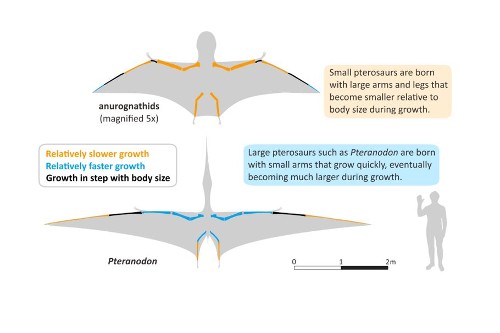University Of Bristol Research Finds Large Pterosaurs Were Better Parents Than Their Smaller, Earlier Counterparts
Small pterosaurs were born with comparatively strong, large wings, which meant they could leave the nest swiftly, while larger, cumbersome baby pterosaurs required parental protection from predators, scientists have discovered.
A team of researchers from Ireland (University College Cork), China (Nanjing and Yunnan Universities) and the UK (University of Bristol and Queen Mary University of London) have analysed rare fossils to show there was an evolutionary trade off between increased parenting and increased size in the flying reptiles.
Their findings, published today on Proceedings of the Royal Society B, reveal that smaller Jurassic pterosaurs babies already had large and tough enough wings when they hatched out of their eggs and could have wobbled into flight perhaps within a day or two of birth.
However, by the Cretaceous, pterosaurs were much bigger, with wingspans of five metres the norm. Some later pterosaurs even reached ten–15 metres, the size of a small glider, and much larger than any known bird.
The babies of all pterosaurs, large and small, were small, restricted by egg size. Investing in childcare by having non-flying babies was offset in evolutionary terms in allowing them to grow into giants of the sky.
“This was a difficult project,” said lead author, Dr Zixiao Yang from University College Cork. “We had to find examples of pterosaurs where we had at least one hatchling or very young specimen as well as adults so we could study their relative rates of growth. In most cases, the delicate skeletons are quite incomplete. Baby pterosaurs are really rare.”
“Luckily, we were able to use some classic specimens from the Jurassic of Europe and the Cretaceous of North America, together with new finds from China,” says Professor Baoyu Jiang from Nanjing University. “By measuring the skulls, backbones, wings, and hind legs, we had the data to assess for differences in relative growth of different parts of the body.”
Professor Michael Benton from Bristol’s School of Earth Sciences said: “The study was all about allometry.
“We are familiar with allometry in human babies, puppies and kittens – their heads, eyes and knees are huge, and the rest of the body grows faster to get to adult proportions. It’s the same with many animals, including dinosaurs and pterosaurs. The babies also have cute faces, with short noses, big eyes, and big heads overall.”
“The bird-sized Jurassic pterosaurs were born with relatively large wings and critically, strong arms and legs, evidence that the babies could fly from birth,” added collaborator Professor Xu Xing of Yunnan University. “As they grew from baby to adult, their arms and legs showed negative allometry, meaning they started large and were then growing more slowly than the rest of the body.”
“But it was different for the Cretaceous giants,” explained Professor Maria McNamara of University College Cork. “They also started as small babies, but the key limb bones show positive allometry through growth, suggesting a very different developmental model.”
“This means that the pterosaur giants had sacrificed low-input childcare to the need to grow huge eventually as adults,” said Dr David Hone of Queen Mary College London. “Minimal childcare makes sense as a starting point for these ancient reptiles because it saves them energy. But to grow huge, the larger pterosaurs had a problem, which was the much longer time it took to become an adult, and the need to protect their young from accidents. The babies of all pterosaurs, large and small, were small because of the limitations of egg size. Investing in childcare by having non-flying babies was offset in evolutionary terms by releasing a constraint on becoming truly huge.”
Dr Zixiao Yang concluded: “We see the same thing in birds and mammals today. Some birds fly very young, and of course some mammals like cattle and antelopes are on their feet the day they are born. But this kind of behaviour is risky for the babies because they are often clumsy and are easy targets for predators; it’s costly also for the mother because the babies have to have highly developed wings or legs at the point of birth. So, we see the same thing in extinct pterosaurs. They were restricted in maximum body size until the end of the Jurassic, at which point their parental care behaviour changed, and then they could achieve huge sizes.”

